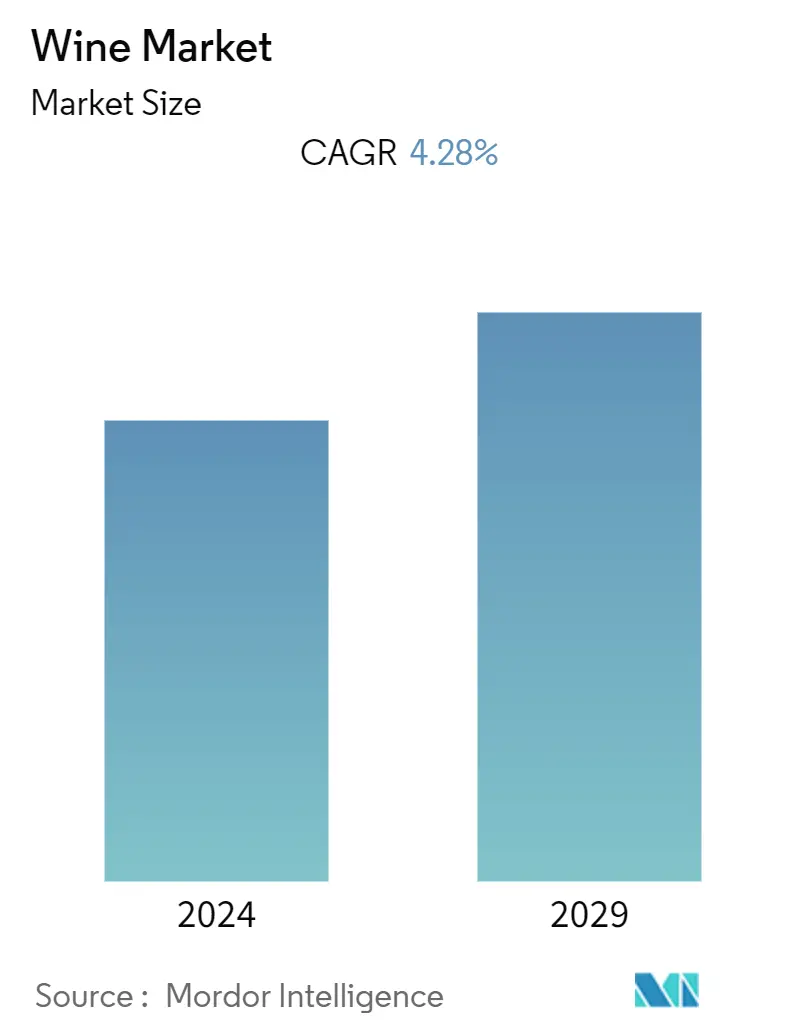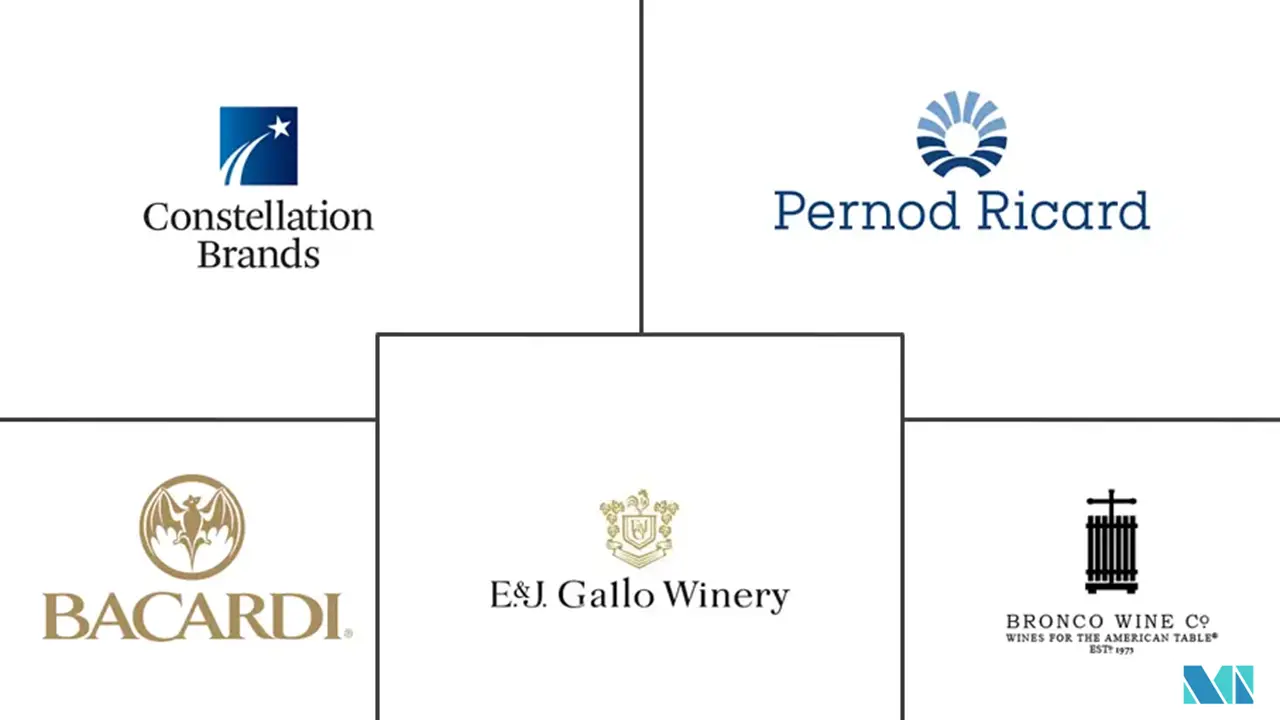Market Size of Wine Industry

| Study Period | 2019 - 2029 |
| Base Year For Estimation | 2023 |
| CAGR (2024 - 2029) | 4.28 % |
| Fastest Growing Market | Asia Pacific |
| Largest Market | Europe |
| Market Concentration | Low |
Major Players
*Disclaimer: Major Players sorted in no particular order |
Wine Market Analysis
The Wine Market is expected to register a CAGR of 4.28% during the forecast period.
The COVID-19 pandemic had a major impact on the wine industry due to the forced closure of on-trade wineries in various countries, such as the United States, the United Kingdom, and India, to control the spread of the virus. However, the current situation may allow the wine industry to recapture lost consumer attention. As per the analysis, the total wine volumes are increasing Y-o-Y as more people are purchasing wine to enjoy with meals at home, majorly in European and North American countries. On the other hand, there is uncertainty about the current boom in the market and off-trade continuing after pantry loading depletes, the on-trade slowly reopens, and consumption behavior returns to pre-COVID-19 levels.
The wine market is likely to be driven by the increasing demand due to its health benefits and premiumization of wine products, coupled with flavor innovation and more advanced distribution networks globally. Due to government policies and new rules and regulations like the legalization of cannabis in the United States and Canada, new flavors are being infused in wines, attracting consumer attention. Changing tastes and new preferences among consumers and increasing demand for new and exotic flavors, such as Riesling wine and other tropical fruit wines, are expected to fuel the growth of the wine market in the future. The market players are forming acquisitions for better market share. For instance, in October 2022, Pernord Ricard announced a partnership with Sovereign Brands to strengthen its portfoilo of luxury wines and spirits
Wine Industry Segmentation
Wine is an alcoholic drink typically made from fermented grape juice. The wine market is segmented by product type, color, distribution channel, and geography. By product type, the market is segmented into still wine, sparkling wine, fortified wine, and vermouth. By color, it is segmented into red wine, rose wine, and white wine. By distribution channel, it is segmented into supermarkets/hypermarkets, specialty stores, online retailers, and other distribution channels. By geography, the market is segmented into North America, Europe, Asia-Pacific, South America, and Middle-East and Africa. For each segment, the market sizing and forecast have been done based on value (in USD million).
| Product Type | |
| Still Wine | |
| Sparkling Wine | |
| Fortified Wine and Vermouth |
| Color | |
| Red Wine | |
| Rose Wine | |
| White Wine |
| Distribution Channel | |
| Supermarkets/Hypermarkets | |
| Specialty Stores | |
| Online Retailers | |
| Other Distribution Channels |
| Geography | |||||||||
| |||||||||
| |||||||||
| |||||||||
| |||||||||
|
Wine Market Size Summary
The wine market is poised for steady growth, driven by increasing consumer interest in its health benefits and the premiumization of wine products. The industry is experiencing a resurgence as consumers shift towards enjoying wine at home, particularly in European and North American regions. This shift is supported by advancements in distribution networks and flavor innovations, which are attracting a diverse consumer base. The legalization of cannabis in regions like the United States and Canada has led to the infusion of new flavors in wines, further capturing consumer attention. The market is also witnessing a trend towards higher-value products, with consumers eager to explore unique and exotic flavors, such as Riesling and tropical fruit wines. This evolving consumer preference is prompting market players to engage in strategic acquisitions and partnerships to enhance their market share and product offerings.
In the Asia-Pacific region, China leads in wine consumption, particularly red wine, due to cultural preferences. Other countries like Australia, Japan, and India are also contributing to the region's growing demand for wine. The market in Brazil and Argentina is expanding, fueled by an emerging middle class and targeted marketing campaigns. The competitive landscape of the wine market is characterized by the presence of both global and domestic companies, with major players like E. & J. Gallo Winery, Constellation Brands Inc., and The Wine Group LLC holding significant market shares. These companies are focusing on product differentiation and strategic acquisitions to strengthen their positions. Recent acquisitions, such as Treasury Wine Estates Ltd's purchase of Ch√¢teau Lanessan and Pernod Ricard's acquisition of Ch√¢teau Sainte Marguerite, highlight the ongoing efforts to build luxury wine portfolios.
Wine Market Size - Table of Contents
-
1. MARKET DYNAMICS
-
1.1 Market Drivers
-
1.2 Market Restraints
-
1.3 Industry Attractiveness - Porter's Five Forces Analysis
-
1.3.1 Threat of New Entrants
-
1.3.2 Bargaining Power of Buyers/Consumers
-
1.3.3 Bargaining Power of Suppliers
-
1.3.4 Threat of Substitute Products
-
1.3.5 Intensity of Competitive Rivalry
-
-
-
2. MARKET SEGMENTATION
-
2.1 Product Type
-
2.1.1 Still Wine
-
2.1.2 Sparkling Wine
-
2.1.3 Fortified Wine and Vermouth
-
-
2.2 Color
-
2.2.1 Red Wine
-
2.2.2 Rose Wine
-
2.2.3 White Wine
-
-
2.3 Distribution Channel
-
2.3.1 Supermarkets/Hypermarkets
-
2.3.2 Specialty Stores
-
2.3.3 Online Retailers
-
2.3.4 Other Distribution Channels
-
-
2.4 Geography
-
2.4.1 North America
-
2.4.1.1 United States
-
2.4.1.2 Canada
-
2.4.1.3 Mexico
-
2.4.1.4 Rest of North America
-
-
2.4.2 Europe
-
2.4.2.1 Germany
-
2.4.2.2 United Kingdom
-
2.4.2.3 Spain
-
2.4.2.4 France
-
2.4.2.5 Italy
-
2.4.2.6 Russia
-
2.4.2.7 Rest of Europe
-
-
2.4.3 Asia-Pacific
-
2.4.3.1 China
-
2.4.3.2 Japan
-
2.4.3.3 India
-
2.4.3.4 Australia
-
2.4.3.5 Rest of Asia-Pacific
-
-
2.4.4 South America
-
2.4.4.1 Brazil
-
2.4.4.2 Argentina
-
2.4.4.3 Rest of South America
-
-
2.4.5 Middle-East and Africa
-
2.4.5.1 United Arab Emirates
-
2.4.5.2 South Africa
-
2.4.5.3 Rest of Middle-East and Africa
-
-
-
Wine Market Size FAQs
What is the current Wine Market size?
The Wine Market is projected to register a CAGR of 4.28% during the forecast period (2024-2029)
Who are the key players in Wine Market?
Bacardi Limited, E. & J. Gallo Winery, Constellation Brands Inc., Pernod Ricard and Bronco Wine Company are the major companies operating in the Wine Market.

